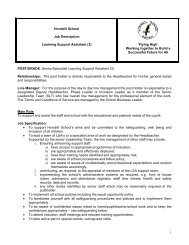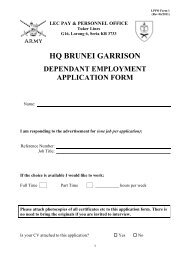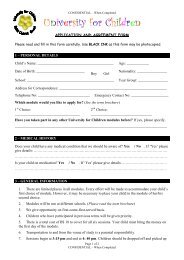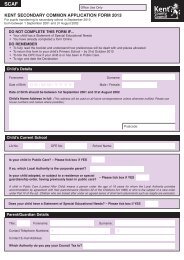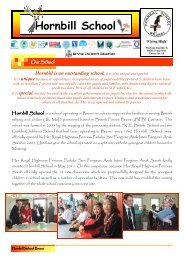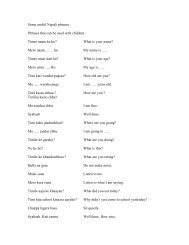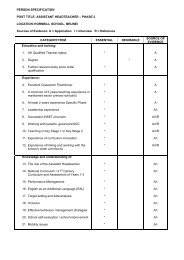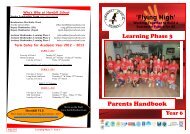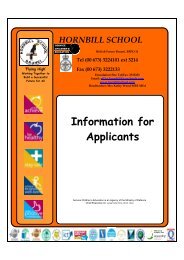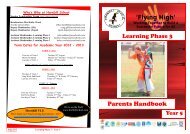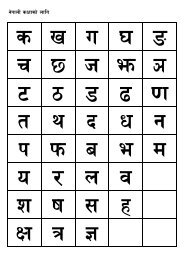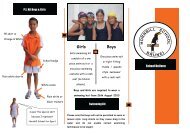2009-2010 - Hornbill School Website
2009-2010 - Hornbill School Website
2009-2010 - Hornbill School Website
You also want an ePaper? Increase the reach of your titles
YUMPU automatically turns print PDFs into web optimized ePapers that Google loves.
• Changing your classroom management;<br />
• Giving them shorter term targets and rewards:<br />
• Giving the child more time;<br />
• Being more flexible;<br />
• Involving someone else to help;<br />
• Involving the Inclusion Leader/support service;<br />
• Bringing in parents on a more regular basis.<br />
36<br />
Marking Policy<br />
1. Introduction<br />
Our marking policy offers guidelines to all our staff on the way in which we respond to<br />
children’s work. In many cases, our response will be to talk with the child about their<br />
work so that we can have a discussion with the child rather than simply making a<br />
written comment. In the cases where this is not possible, we try to mark their work in<br />
an honest, positive and supportive way that will encourage them to make progress at<br />
their next attempt.<br />
We also recognise that marking children’s work offers information which we can use in<br />
assessing the level of their skills, knowledge and understanding of the task they have<br />
undertaken. In this way, information gained from marking children’s work informs<br />
planning of the next step that the child needs to take in their learning.<br />
2. The purpose of marking children’s work<br />
At <strong>Hornbill</strong>, we believe that marking our children’s work serves the following purposes:<br />
To show that we value our children’s work and the effort they have made.<br />
To give an indication of the professional opinion of a child’s work, to outline<br />
expectations of them and to discus with them achievable targets.<br />
To enable us to assess how much the child has understood.<br />
To provide a basis for making assessments linked to the National Curriculum<br />
levels of achievement.<br />
To identify areas for development and inform IEPs or ITSPs.<br />
To motivate and encourage the child through positive and constructive<br />
comments which will help them to make progress.<br />
3. Common principles about how we mark children’s work<br />
We mark all our children’s work in graphite pencil or black or blue pen or in<br />
those colours agreed in our school editing keys. (Copies of KS1 and KS2<br />
keys attached.)<br />
We try to use the child’s name in a written comment because we fell this<br />
makes it personal.<br />
We would never want the amount of correction to be over-facing for a child,<br />
even when there are many errors.<br />
We endeavour to use the Nelson style of handwriting when writing<br />
comments in order to provide a model.<br />
Often we prefer to take a selected paragraph in a longer piece of written<br />
work or a particular section of maths work and mark in a pre-determined<br />
focus – this then informs future planning.



